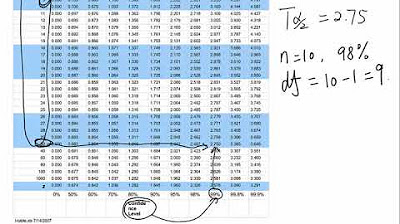Degrees of Freedom Explained
TLDRThis educational video script delves into the concept of 'degrees of freedom' (DF) in the context of contingency tables and chi-square tests. It clarifies that DF is crucial for understanding test results and is calculated as (number of rows - 1) * (number of columns - 1). The script uses a mock survey example to illustrate how DF limits the number of cells that can vary independently in a table, with the rest determined by the totals. It also touches on the importance of having a sufficient DF for the chi-square distribution to approximate a normal distribution, hinting at modifications like Yates' correction for small sample sizes. The explanation is aimed at helping viewers grasp the foundational principle of DF in statistical analysis.
Takeaways
- 📚 Degrees of freedom (DF) is a concept often discussed in statistics, specifically in the context of contingency tables and chi-square tests.
- 🔢 The term 'degrees of freedom' is abbreviated as DF and is used in calculators when performing chi-square tests.
- 📉 Degrees of freedom is calculated as (number of rows - 1) * (number of columns - 1) for a contingency table.
- 🔑 The formal definition of degrees of freedom is the number of elements in a system that are allowed to vary freely.
- 🧩 In a contingency table, once you know the totals and one value within a cell, the rest of the values are determined because they must add up to the given totals.
- 📈 As the degrees of freedom increase in a table, the chi-square distribution more closely resembles a normal distribution.
- 🚫 A chi-square test should not be conducted if the degrees of freedom are less than two.
- ⚠️ If a table has a very low degrees of freedom, modifications like the Yates' correction may be applied, although this is discussed further in class.
- 📊 The script provides examples of how to calculate degrees of freedom for both a 2x2 table (one degree of freedom) and a larger table (two degrees of freedom).
- 📝 It is important for students to understand and be able to explain the concept of degrees of freedom, not just perform the calculation.
- 📚 The video script suggests that upcoming videos will cover chi-square tests in more detail, emphasizing their importance for understanding and exam preparation.
Q & A
What does the term 'degrees of freedom' refer to in the context of a chi-square test?
-In the context of a chi-square test, 'degrees of freedom' refers to the number of independent pieces of information available to calculate a statistic. It is calculated as (number of rows - 1) * (number of columns - 1) for a contingency table.
Why is it important to understand the concept of degrees of freedom?
-Understanding degrees of freedom is important because it determines the number of independent cells in a contingency table that can vary freely. It also affects the shape of the chi-square distribution, which is crucial for the validity of the chi-square test.
What is the minimum number of degrees of freedom required to perform a chi-square test?
-The minimum number of degrees of freedom required to perform a chi-square test is one. However, if the degrees of freedom are less than two, the chi-square test is not recommended due to the distribution not closely resembling a normal distribution.
How does the chi-square distribution change with an increase in degrees of freedom?
-As the degrees of freedom increase, the chi-square distribution becomes more symmetrical and starts to resemble a normal distribution. This is important for the statistical validity of the chi-square test.
What is a contingency table?
-A contingency table is a type of table in statistics that is used to display the frequency distribution of two or more categorical variables. It is often used in chi-square tests to analyze the relationship between these variables.
How does the total number of people surveyed affect the degrees of freedom in a contingency table?
-The total number of people surveyed does not directly affect the degrees of freedom. The degrees of freedom are determined by the number of rows and columns in the contingency table, not by the total number of observations.
What is a 'Yates' correction often mentioned in the context of chi-square tests?
-The 'Yates' correction is a modification to the calculation of the chi-square statistic that is used when sample sizes are small. It adjusts the chi-square value to reduce the likelihood of a Type I error, which is the incorrect rejection of a true null hypothesis.
If the observed values in a contingency table are known, how does this affect the degrees of freedom?
-Knowing the observed values in a contingency table does not change the degrees of freedom. The degrees of freedom are a structural property of the table based on its dimensions (rows and columns), and they are determined before any data is entered into the table.
What happens when all degrees of freedom are used up in a contingency table?
-Once all degrees of freedom are used up, every cell in the contingency table has a determined value. No more cells can vary freely because they must all add up to the row and column totals.
Why is it necessary to include an explanation of degrees of freedom in a written analysis (IA)?
-Including an explanation of degrees of freedom in a written analysis is necessary to demonstrate a comprehensive understanding of the statistical concepts being used. It also helps to justify the calculations and methods applied in the analysis.
How does the video script help in understanding the concept of degrees of freedom?
-The video script provides a step-by-step explanation of degrees of freedom using examples of contingency tables. It illustrates how to calculate degrees of freedom and how placing values in a table reduces the degrees of freedom as cells become determined by the totals.
What is the relationship between the degrees of freedom and the validity of statistical tests like the chi-square test?
-The degrees of freedom are directly related to the validity of statistical tests like the chi-square test. A higher number of degrees of freedom generally provides a more reliable test result, as the chi-square distribution more closely approximates a normal distribution.
Outlines
📊 Understanding Degrees of Freedom in Contingency Tables
The speaker introduces the concept of degrees of freedom (DF) in the context of contingency tables and chi-square tests. They explain that DF is crucial for understanding statistical tests and exams. The video uses a mock contingency table with observed values to illustrate the calculation of DF, which is (number of rows - 1) * (number of columns - 1). In a 2x2 table, this results in one degree of freedom, meaning only one cell's value can vary independently; the rest are determined by the totals. The importance of DF is emphasized, as it affects the shape of the chi-square distribution, with more DF leading to a distribution that more closely resembles a normal distribution. The video also mentions that a chi-square test is not feasible with less than two degrees of freedom and hints at possible modifications for small DF.
🔢 Calculating Degrees of Freedom with a Larger Contingency Table
The speaker continues the discussion on degrees of freedom, this time with a larger contingency table that has more degrees of freedom. They calculate the DF for a table with T rows and three columns, resulting in (T-1) * (3-1) = 2 degrees of freedom. This means two cells can vary freely, with the rest of the table's values being determined once these are set. The speaker creates a hypothetical survey scenario with 20 males and 20 females, and assigns values to the table to demonstrate how the degrees of freedom are used up as values are filled in. They emphasize the importance of understanding and explaining degrees of freedom in assignments and exams, as it is a fundamental concept in statistical analysis.
📚 Importance of Degrees of Freedom in Statistical Analysis
In the final paragraph, the speaker stresses the importance of understanding degrees of freedom when conducting a chi-square test. They advise students to provide explanations for their calculations, not just the results, to demonstrate a comprehensive understanding of the concept. The speaker also promises to release more videos on chi-square tests and encourages students to watch them for a better grasp of the subject, as understanding the processes will be beneficial for exams. The video concludes with words of encouragement for the students, highlighting the value of continued learning and engagement with the material.
Mindmap
Keywords
💡Degrees of Freedom (DF)
💡Contingency Table
💡Chi-square Test
💡Observed Values
💡Totals
💡Yates' Correction
💡Normal Distribution
💡Independence
💡Chi-square Distribution
💡Statistical Significance
Highlights
Degrees of freedom is a concept often encountered in statistics, particularly in the context of contingency tables and chi-square tests.
Degrees of freedom (DF) refers to the number of values in a dataset that are free to vary independently of one another.
The calculation for degrees of freedom in a contingency table is the number of rows minus one, times the number of columns minus one.
In a two-by-two contingency table, there is only one degree of freedom, meaning only one cell's value can vary independently.
Once a value in a cell is known, the values of the other cells are determined by the totals of the table.
The concept of degrees of freedom is crucial for understanding how chi-square tests work and their statistical significance.
As the degrees of freedom increase, the chi-square distribution more closely resembles a normal distribution.
A chi-square test cannot be performed if the degrees of freedom are less than two.
The video discusses potential modifications to calculations when degrees of freedom are low, such as the Yates correction.
The presenter illustrates the concept with a mock contingency table, showing how degrees of freedom are determined and how values are constrained by totals.
In a larger contingency table with more rows and columns, there are more degrees of freedom, allowing for more independent variation.
The importance of understanding degrees of freedom is emphasized for both academic and practical applications in statistics.
The video provides a step-by-step example of how to calculate degrees of freedom and apply it to a hypothetical survey data scenario.
Understanding the concept of degrees of freedom is essential for interpreting the results of chi-square tests accurately.
The presenter advises viewers to include explanations of degrees of freedom in their academic work to demonstrate a thorough understanding.
The video concludes with an encouragement to continue watching related content for a comprehensive understanding of chi-square tests.
The importance of not only performing calculations but also understanding the underlying concepts is stressed for success in exams and practical applications.
Transcripts
Browse More Related Video

What are Degrees of Freedom?

The Sample Variance and its Chi Squared Distribution

Find T Score(T Value) from T Table for Confidence Interval

Chi-square distribution introduction | Probability and Statistics | Khan Academy

What is Degrees Of Freedom in Statistics? Degrees of freedom in Statistics Explained!

Degrees Of Freedom in a Chi-Squared Test
5.0 / 5 (0 votes)
Thanks for rating: